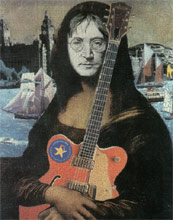
| HOME |
| NERVE |
| REVIEWS |
| ARCHIVE |
| EVENTS |
| LINKS |
| ABOUT US |
| CONTRIBUTORS |
| BACK ISSUES |
| CONTACT US |
 “A
Load of Rubbish?”
“A
Load of Rubbish?”
Alex Corina at the View 2 Gallery, Mathew Street
Reviewed by Barbara Jones
An exhibition of work produced between 1999 and 2004 by Liverpool artist Alex Corina.
In considering Alex’s work as a “load of rubbish” I mean it in the nicest, possible sense. For he presents us with art which derives from recycled and reclaimed materials. His starting point was a series of photographic portraits of life model Phil Williams, which he manipulated and distorted by using photographic emulsion, paint and collage techniques. He was influenced by Francis Bacon’s distortion paintings of human figures and this was the beginning of Alex’s interest in the “human condition”.
An encounter with health problems led him to confront mortality and made him consider the longevity of classical art and sculptures which are restored and repaired and have the potential to live “forever”, whereas we become old, frail and damaged. Strangely, the day of the opening of this exhibition saw the destruction of priceless artworks by the likes of Tracey Emin and Damien Hirst in a warehouse fire in London. It’s interesting to consider that such work will now only remain in the memory or by way of photographs.
So Alex decided to take photographic representations of revered classical sculptures, such as Michelangelo’s “David”, and “damage” their beauty by using similar unpredictable photo-emulsion and collage techniques to those used on the portraits. He calls this series his “recycled classic heads”. However, in creating these two dimensional distortions of classical sculptures he revealed a paradox in that, despite his irreverent treatment, the resulting art still possesses a curious beauty.
A series of etchings followed which employed a similar combination of photographs of found scrap material with classical images. By now Alex’s work was increasingly process-led as he allowed for the unpredictability of the materials he was working with. The use of “Lazertran” became an integral part of this process since it allowed for the transfer of photographic images onto various materials and this meant that he could fully explore its potential as an artistic tool. This was when scrap metal, in the form of dustbins, became the vehicle for more classical imagery. Again, we can still discern incredible beauty through the decay and destruction of these battered and damaged supports.
It was at this time that the campaign for the Capital of Culture bid
had begun in earnest and these notions of “culture” had real
relevance for the ideas behind Alex’s art. He used collage techniques
to create the, now famous, “Mona Lennon”, a composite work
which brings together Leonardo’s “Mona Lisa” with the
face of John Lennon against a background of recognisable landmarks of
Liverpool. A funny, quirky image, it was adopted by the Capital of Culture
bid team and placed outside St. George’s Hall on two 80 foot high
banners.
The “Mona Lennon” image has now been used in various different
contexts in a similar vein to the “recycled classical heads”
series. “Lazertran” has enabled the successful transfer of
“Mona Lennon” onto metal bin lids and other fragments with
the aim of potential destruction of a new/classical image. Influenced
by Andy Warhol’s screenprints of such figures as Marilyn Monroe,
a modern day icon, he has also made a collage of “Mona Lennon”
which capitalises on the accidental and unpredictable process of lazertran
in the same way that Warhol deliberately exploited the possible mistakes
and misregistering of the screenprint process. The viewer’s eyes
scan every inch of this work in an attempt to read every detail and “flaw”.
I found it interesting to note that, in placing the classical portrait painting onto twisted metal, Alex has now moved from transforming the three dimensional classical sculptures of his earlier work into two dimensional images, to changing two dimensional, painted images into three dimensional, sculptural pieces.
His most recent work brings together all of his ideas and influences in another witty and intriguing way. A collection of pigeon-holes are used to display recycled drinks cans upon which we can detect classical images as well as Alex’s own creation, the “Mona Lennon”. Here it appears that he is taking discarded drinks cans and placing other images on them, thereby re-inventing and revitalising the objects as art. We are presented with a mixture of classical and modern-day icons. Repetition is a very important element here, as is the fact that the pigeon-holes themselves are constructed from re-claimed wood. The most successful of these is the series where the colourful original can image is seen alongside the imposed classic image, especially where the brand catchphrase, e.g. “Refresh your Head”, has relevance for the accompanying image, e.g. the head of Michelangelo’s “David”.
My particular favourite is the series of Virgin cola cans portraying the face of the Virgin Mary from Michelangelo’s “Pieta”. The monochrome nature of this set of cans adds to the effect of repetition and the quirky juxtaposition of the brand “Virgin” with the utterly recognisable image of the Virgin Mary brings a smile to the viewer’s face.
I have an interest in using supposed “rubbish” for the purpose of art so this body of work is particularly inspiring for me. Once you can see beauty and the potential for art in an old dustbin or a twisted, empty can, you realise that beauty and art exist all around us in the everyday “rubbish” of life.
The exhibition continues until Wednesday 23rd June.